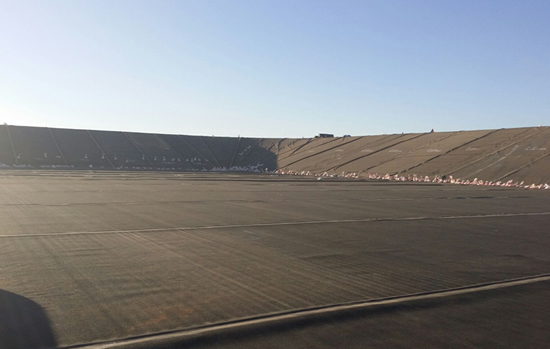
 During EuroGeo 6 (25 – 28 September 2016, Istanbul), Dr. Ian D. Peggs will moderate a panel discussion on “Managing Wrinkles, Bridging and Ballasting During Geomembrane Liner Installation.” The session is one of seven Specialty Sessions to be held at the conference, which is the 6th European Conference on Geosynthetics.
During EuroGeo 6 (25 – 28 September 2016, Istanbul), Dr. Ian D. Peggs will moderate a panel discussion on “Managing Wrinkles, Bridging and Ballasting During Geomembrane Liner Installation.” The session is one of seven Specialty Sessions to be held at the conference, which is the 6th European Conference on Geosynthetics.
Presentations for the geomembrane wrinkles session include:
- Managing Wrinkles, Bridging, and Ballasting During Geomembrane Installation
Ian D. Peggs, I-CORP INTERNATIONAL, Inc. (USA) - Suggested Practice in USA for Geomembrane Wrinkles in Bottom Liners for Waste and Mine Stacks
Richard Thiel, Thiel Engineering (USA) - Wrinkles, Bridging, and Ballasting Geomembrane During Installation
Mario Garcia Girones and Adnan Berkay Ozdemir, Atarfil (Spain, Turkey) - Geomembrane bridging issues in lagoon based anaerobic digesters
Michael Flynn, FLI Group (Ireland) - The importance of the choice of the products
Paul Guinard, SOPREMA (France) - Wrinkling and Bridging – Can it be kept to a minimum? Best practices
Catrin Tarnowski, GSE Lining Technology (Germany)
Each presenter has submitted an abstract. The full group of six abstracts is available for download (PDF), courtesy of the session moderator.
GEOMEMBRANE WRINKLES, BRIDGING, AND BALLASTING
Dr. Peggs’ abstract provides a nice summary of numerous issues that the international panel of speakers will discuss with the audience. Peggs writes:
There have recently been a number of geomembrane liner installation projects involving ponds and dams where concern has been expressed about the occurrence of bridging, wrinkles, wind uplift, and associated ballasting. For instance most liner installation projects state that there shall be no bridging in corners or at the toes of slopes. In locations where there are wide swings in diurnal temperature and daily temperatures bridging can appear and disappear. Is it important that bridging be removed if it occurs at the lower installation temperatures when pond filling will occur at higher temperatures and service temperatures will be higher when no bridging is observed? Should we require no bridging over a specific temperature range? Is bridging worse than an area of repair extrusion welds? Can bridging be resolved by ballasting the liner until it touches the ground? For all materials? How do we repair wrinkle-type bridging along a seam?
At the high end of installation temperatures wrinkles can occur. At what size/geometry do they become unacceptable? Height more than twice the width? When they can flop over? How do we repair wrinkles? Or how do we prevent them forming in the first place? On steep slopes and walls geomembranes expand and excess material travels downslope, but does not contract back upslope during lower temperatures. How many thermal cycles should we allow before removing the wrinkle and repairing the liner? Can and should we avoid horizontal extrusion seams at the toes of slopes?
A more specific wrinkle problem occurs on dams where the wrinkled liner is to be covered by about 100 mm of concrete. What is the maximum size of wrinkle that can be allowed to prevent stress concentrating notches initiating cracking of the concrete?
Ballasting can clearly be used to prevent/minimize movement of the geomembrane both laterally and vertically. Typically, when ponds are to be empty as a part of their operating cycle ballast unit weights and their distribution are defined by the project engineer. However, this is typically to prevent wind uplift rather than to manage expansion (wrinkles) and contraction (bridging). But who is responsible for ballast placement during liner installation? Certainly the installer is responsible for ballasting to prevent the liner from blowing away altogether, but is the installer, the engineer, or are both of them responsible for ballasting for the management of wrinkles and bridging?
One area where the engineer typically does not assume the responsibility he/she should is in the specification of the amount of compensation to be built into the liner between fixed points subject to contraction, remembering that the geomembrane should function solely as a barrier and not as a load-bearing member of the lining system.
General contractors take note, and hear European liner experts present their opinions on these installation details that can only improve the lifetime of geomembrane lining and containment systems.
EUROGEO 6 SPECIALTY SESSIONS
Other Specialty Sessions at EuroGeo 6 include:
- Geosynthetic Barriers
Organized by Kent von Maubeuge and Dr. Nathalie Touze-Foltz - Geosynthetics in Dam Construction
Organized by Dr. Eng. Alberto Scuero - Geosynthetic Reinforcement Applications
Organized by Gerhard Bräu - Geosynthetics in Road Construction
Organized by Prof. Erol Tutumluer - Surface Erosion Control and Drainage
Organized by Pietro Rimoldi - Behavior and Performance of Geosynthetics Under Earthquake Shaking
Organized by Prof. George Athanasopoulos
The Turkish Chapter of the International Geosynthetics Society (IGS) is hosting EuroGeo 6 and invites your participation. The full program will be available soon. (Final papers were collected through June 15.)
The European Conference on Geosynthetics is held every four years, with the last being 2012 in Valencia, Spain.
Learn more and register at www.EuroGeo6.org.











